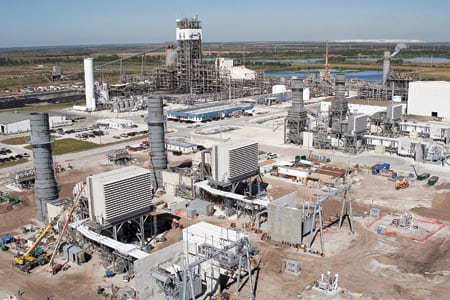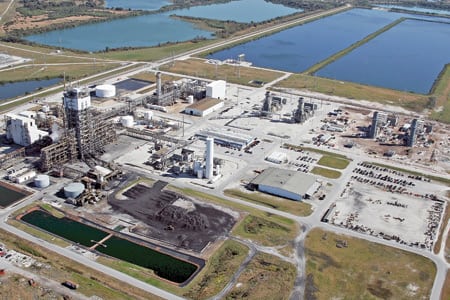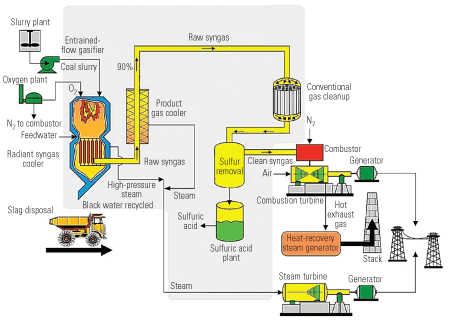Polk Power Station Unit 1, Mulberry, Florida
Tampa Electric Co. (TECO) owns and operates Polk Power Station as part of its regulated generation fleet in Central Florida. The plant (Figure 1) occupies 4,300 acres in Polk County, about 40 miles southeast of Tampa. One-fifth of the integrated gasification combined-cycle (IGCC) project’s $600 million capital cost was paid for by the U.S. Department of Energy as part of its Clean Coal Technology Program. Now called Unit 1, the plant was commissioned and placed into commercial service in late 1996. During its first five years of operation, the plant operated successfully on a number of different fuels that were part of the DOE demonstration plan.

1. First in class. Polk Power Station Unit 1 has the lowest production cost of any plant in the Tampa Electric system. Courtesy: TECO
In the May/June 1997 issue of POWER, the editor wrote: "In many ways Polk [now Unit 1] is among the most challenging generation projects ever undertaken in the power industry [and] with continued refinement, Polk’s efficiency will make the unit even more valuable to the utility." Those words have proved prescient, because America’s first "greenfield" IGCC plant now performs better than most pulverized coal (PC) plants. Unit 1, which typically operates in baseload mode, currently boasts the lowest incremental cost in the TECO system.
The coal gasification portion of Unit 1 (Figure 2) uses entrained-flow, oxygen-blown technology that was developed by Texaco and later purchased by General Electric Co. Power is generated by a 315-MW 1 x 1 combined-cycle plant whose GE 7FA combustion turbine fires either the output of the gasifier or distillate oil. The turbine is rated at 192 MW when firing the syngas, with diluent nitrogen for NOx control. Complementing the 7FA are a 123-MW GE D11 steam turbine-generator and a triple-pressure heat-recovery steam generator from Vogt Power International (www.babcockpower.com). The oxygen plant consumes 55 MW, and other auxiliaries require 10 MW, so the net power delivered to the grid is 250 MW. The IGCC unit’s heat rate is about 9,300 Btu/kWh on a steady-state basis when firing syngas.

2. Harness the power. Unit 1 produces 315 MW (gross), but the oxygen plant consumes 55 MW, and auxiliaries eat up another 10 MW, leaving 250 MW for delivery to the grid. Courtesy: TECO
The road to success
At the plant’s dedication on January 10, 1997, then-Secretary of Energy Hazel R. O’Leary congratulated TECO and TECO Power Service Corp. for the successful start-up of a facility she said "will help redefine the world’s use of coal. With this technology, we can show the world how to use its wealth of coal to power economic growth without endangering the environment. It will herald a new era for clean energy from coal."
And clean it is. Even when burning low-cost coal feedstocks, Polk emits less SO2, NOx, and particulates than most PC plants. With over 98% removal of SO2, emissions of that pollutant are typically 0.12 lb/mmBtu. NOx emissions, which are reduced by syngas saturation, are currently averaging 11 ppm (corrected to 15% O2). Particulate emissions also are extremely low, at 0.04 lb/MWh.
TECO has faced and met so many operational challenges at Polk that it has announced development of a second IGCC plant there (see box). The planned investment is perhaps the best indicator of the company’s comfort level with the technology. Polk’s 95% unit equivalent availability with backup fuel compares quite favorably to the 78% average availability of a U.S. coal plant. Polk’s gasifier is currently operating at a 72% capacity factor and an equivalent availability of 78% on syngas. Those numbers, which are somewhat lower than would be expected for a next-generation IGCC plant, are due to a few troublesome pieces of equipment such as convective syngas coolers, which will be eliminated in future units (Figure 3).

3. Go with the flow. A simplified process flow diagram of TECO’s Polk Power Station Unit 1 illustrates the complexity of the IGCC process. Source: U.S. DOE
Plenty of speed bumps
The road to reliability hasn’t always been smooth, and the inevitable growing pains in the early years were alleviated by doses of good engineering and excellent O&M practices. For example, the plant has five teams of 10 IGCC specialists, all with journeyman-level skills. They are responsible for the O&M of the plant; there are no first-level supervisors. The specialists’ on-the-job training will be invaluable as the fledgling IGCC industry matures in the U.S. over the next decade. And the maturation and acceptance of the technology will be accelerated by two key stats: Polk is TECO’s lowest incremental-cost generating unit and one of the cleanest coal-fired power plants in the U.S.—if not the world.
The reliability and availability of Polk’s IGCC unit have improved steadily since it entered commercial service. Of the 34,800 hours logged by the combustion turbine over the five-year demonstration period, 28,500 were syngas-fired, producing over 8.6 million MWh of electricity. The gasifier’s on-stream factor steadily increased, reaching 70% to 80% after 2.5 years. The overall unit’s availability, with distillate fuel as backup, averaged 90% after 1.5 years.
Improvements have come slowly but have built an experience base that is now paying dividends. The unit’s start-up challenges and problems are not too different than those of a coal- or gas-fired plant, with some chemical processing steps added for extra interest. During Polk’s first few years of service, many small glitches contributed to lower-than-expected availability, but those problems were not attributable to basic IGCC technology. For example, the erosion and corrosion of piping and the plugging of syngas coolers with ash were expected. The many nuisance shutdowns were addressed one at a time and resolved.
In the second year of operation, particulate damage to the combustion turbine was solved by adding a syngas filter. At the same time, operators learned how to do faster "hot" starts to improve the unit’s dispatchability. They also figured out how to reduce the auxiliary power required during a start-up or shutdown. The losses add up quickly because the gasifier’s refractory lining takes several days to cool down, and 30 to 36 hours to heat up again using propane gas.
The next few years saw the longest uninterrupted period of power generation by the combustion turbine to date: 52 days, with 16 transfers between syngas and No. 2 oil. Before then, the longest uninterrupted gasifier run was 37 days. Ash plugging of the convective syngas coolers remained a nagging problem. The gasifier’s refractory was replaced after 451 days of operation (representing over two years of service and 73 gasifier start-ups on 10 different fuels or fuel blends). Despite the additional O&M costs, Polk still became the unit with the lowest production cost in TECO’s fleet and the first unit to be dispatched.
Bumps encountered and avoided
By the last year of the DOE demonstration program, the gasification plant was operating quite well. Many of the many nuisance problems had been solved, and the plant could be brought on-line much faster. Furthermore, fewer instances of corrosion and tube plugging problems had demonstrated that a wide range of fuel types could be burned with little impact on plant performance.
However, during the demonstration period, frequent fuel switches and the high number of start-up and shutdown cycles shortened refractory liner life and accelerated refractory spalling. Tests indicated that a blend of 45% Black Beauty and Mina Norte coals and 55% petroleum coke delivered three positive results: extended refractory life, improved performance characteristics, and extremely competitive production costs (at the time, 33% lower than a PC plant’s and 25% less than that of a natural gas burner).
The inability to directly measure refractory temperatures in real time slowed resolution of the problem; thermocouples failed quickly when exposed to the temperatures in the gasifier’s flow path. Being able to directly monitor and control gasifier temperatures, as opposed to relying on inferential measurements, is critical for controlling slag and flyash formation.
After the first four years of service, Polk’s gasifier and associated systems had steadily improved their availability to 70% to 80% before suffering a frustrating setback in the fifth and final demonstration year. The failure of the air separation unit’s main compressor caused a one-month forced outage that pulled down the fifth year’s operating stats. Coincidently, another lengthy planned outage was required to deal with gasifier refractory damage caused by frequent feedstock changes and the replacement of sootblower lances.
During that star-crossed year, after reexamining Polk’s air quality permit, the State of Florida requested that TECO retrofit the combustion turbine with a selective catalytic reduction system, although the technology had never been proven on an IGCC plant. TECO responded by adding the syngas saturation process to achieve 15 ppm NOx. Despite the lengthy outages, Polk’s on-peak availability for 2000 (year 4) and 2001 (year 5) was 94.9% and 97.7%, respectively (Figure 4).

4. Winning stats. Polk Unit 1 continues to improve its performance, despite problems with the combustion turbine and the air separation unit that are unrelated to syngas production. The average coal plant availability is about 85%. Source: TECO
Carbon in the slag also was a nagging problem; a newly designed slag screen was the solution. Another related problem: The gasifier’s carbon conversion rate was in the low to mid-90% range, much lower than the 98% typical of small Texaco gasifiers. As a consequence of the air separation unit’s inability to meet the gasifier’s entire oxygen demand, and the need to recycle excess flyash, Polk Unit 1 had to be derated to 235 MW, net. The capacity of the solids-handling system had to be doubled so the plant could continue to burn low-quality fuels and maintain its design rating of 250 MW.
Until the fifth year, the block’s availability when firing syngas or distillate was about 90%. In 2003, problems were discovered in the generators of both the combustion and steam turbines that required a rewind of both rotors. Later that same year, a recommended inspection uncovered a crack in the combustion turbine that required a rotor replacement. These problems were associated with early production units and were not related to the use of syngas.
Among the other steps taken to resolve nagging problems were these:
- The convective syngas coolers were redesigned to reduce plugging.
- The radiant syngas cooler seals were redesigned and replaced.
- The raw gas/clean gas heat exchangers, which were found to be suffering from stress-corrosion cracking, were initially repaired and permanently removed later.
- A COS hydrolysis unit was added to meet sulfur-reduction targets, along with an ion-exchange unit for preventing buildup of heat-stable salts in the methyl diethanolamine unit.
- The installation of "Y" strainers and a 10-micron filter system proved critical to protecting the combustion turbine from pipe scale during start-ups. The filter was sized to capture and hold one year’s worth of scale.
- All carbon steel parts that make contact with the slurry feedstock were replaced or coated. High-wear areas were hardened.
Well-deserved success
Polk was functioning as a well-oiled machine by year eight (2004) and posted the best performance to date: 82% and 96% availability for the gasifier and the power block, respectively. The aforementioned incremental improvements to shorten start-up times and reduce parasitic power consumption were made the following year. Unfortunately, that’s when the failure of another main compressor—the one feeding the combustion turbine—caused a 100-day forced outage unrelated to syngas production. TECO took advantage of the outage to make a number of system modifications, including one to add compressor extraction air to the gasifier to increase overall unit output.
In POWER’s 1997 Plant of the Year article on Polk, the editors also noted the plant’s capability to turn a pollutant into a product. "One way coal-fired generation can compete in the next century," they wrote, "is if the fuel is considered for more than its heating value, and the facility more than just a power plant." Indeed, upgrades to Polk’s gasifier systems allow for recovery of sulfuric acid and its sale to local phosphate producers. Slag also is recovered and put to beneficial use in the making of cement. Polk even has reduced its water consumption and continues to operate with zero process water discharge.
Today, the plant continues to operate reliably, having generated more than 13 million GWh while meeting every limit in its environmental permit. SO2 removal remains at an industry-leading 98%+ level, with NOx emissions below 15 ppm. Polk’s steady-state heat rate of about 9,300 Btu/kWh (37% efficiency, HHV) compares favorably with other coal-fired power plants in the U.S.
—Mark Hornick ([email protected]) is general manager of Polk Power Station.